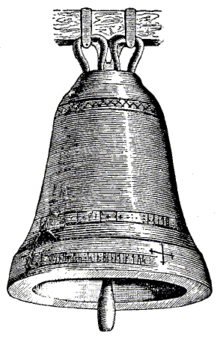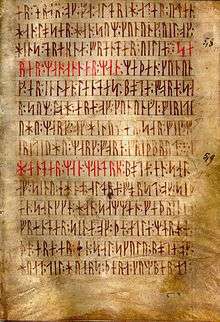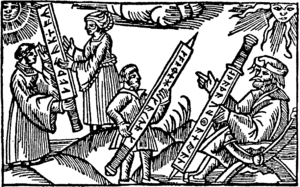Medieval runes
| Medieval runes | |
|---|---|
| Type |
alphabet
|
| Languages | North Germanic languages |
Time period | 12th to 17th centuries |
Parent systems | |
Child systems | Dalecarlian runes |
The medieval runes, or the futhork, was a Scandinavian 27 letter runic alphabet that evolved from the Younger Futhark after the introduction of dotted runes at the end of the Viking Age and it was fully formed in the early 13th century. Due to the expansion, each rune corresponded to only one phoneme, whereas the runes in the preceding Younger Futhark could correspond to several.[1]
The medieval runes were in use throughout Scandinavia during the Middle Ages, and provided the basis for the appearance of runology in the 16th century.
History

Towards the end of the 11th century, the runic alphabet met competition from the introduced Latin alphabet, but instead of being replaced, the runes continued to be used for writing in the native Old Norse language. The Latin alphabet, on the other hand, was mainly used by the clergy for writing in Latin, but also Latin prayers could be written down with runes. Whereas the Latin letters were written with quill and ink on expensive parchment, the runes were carved with sharp objects on prepared wood staffs that were cheaper[2] (see e.g. the Bryggen inscriptions).
Although, it may at first appear that the church did not provide a congenial environment for tradition of writing in medieval runes, there are many known church objects that were engraved with runes, such as reliquaries, bells, baptismal fonts, iron work on church doors, church porches and church walls.[3] In fact, one of the last runestones was raised in memory of the archbishop Absalon (d. 1201).[4]
Most of the runes in the medieval runic alphabet can be traced back to forms in the Younger Futhark as the runemasters preferred to use, or modify, old runes for new phonemes rather than invent new runes.[5]
At the end of the 10th century, or the early 11th century, three dotted runes were added in order to represent the phonemes in a more exact manner. Rather than create new runes for the /e/, /ɡ/ and /y/ phonemes, dots were added to the i, k and u runes.[5]
At the mid-11th century, the ą and the R runes had become obsolete, and instead they were reused for other phonemes. When the distinction between /r/ and /ɽ/ was lost, the R rune was used for /y/ instead, and when the nasal /ɑ̃/ changed into /o/, this became the new phoneme for the ą rune.[5]
Towards the end of the 11th century and in the early 12th century, new d and p runes were created through the addition of dots to the t and b runes.[5]

When the medieval runic alphabet was fully developed in the early 13th century, it mixed short-twig and long-branch runes in a novel manner. The short-twig a rune represented /a/, while the long-branch one represented /æ/. The short-twig ą rune represented /o/, whereas the long-branch form represented /ø/.[5]

As the two alphabets were used alongside each other, there was a mutual influence. The Latin alphabet early borrowed the þ rune to represent the /θ/ and /ð/ phonemes, but in Denmark it was rarely used. In the 15th century, Norwegians and Swedes also stopped using the þ letter, but the Icelanders still retain it in their Latin alphabet. Due to the Latin alphabet the m and the l runes changed places so the rune row read fuþorkniastblmy (note that the last rune had come to represent the /y/ phoneme). In addition, Scandinavians began to double spell runes for consonants, influenced by this use in the Latin alphabet.[2]
In the oldest Scandinavian manuscripts that were written with Latin letters, the m rune was used as a conceptual rune meaning "man". This suggests that the medieval Scandinavian scribes had a widespread familiarity with the names and the meanings of the individual runes. In the oldest preserved manuscript of the Poetic Edda from 1270, and which is written with the Latin alphabet, the m is used as a conceptual rune meaning "man" and in Hávamál it appears 43 times.[6]
In the early 13th century, the runes began to be threatened by the Latin letters as the medieval Scandinavian laws were written. Until then, the laws had been memorized and recited by the lawspeakers. Still, when the runes began to experience competition, they went through a renaissance. A thorough reformation of the runes appeared and the medieval runes reached their most complete form. This may be because the laws were written down, and the oldest manuscript with a Scandinavian law, the Codex Runicus, was written entirely in runes.[6]
Early modern legacy

The Latin letters were introduced officially during the 13th century, but farmers, artisans and traders continued to write with runes to communicate or to mark goods.[6] It appears that in many parts of Sweden, people considered Latin letters to be a foreign practice throughout the Middle Ages.[7] Still in the 16th century, the runes were engraved on official memorials or as secret writing in diaries.[6] In the mid-16th century, the parson of the parish of Runsten[8] on Öland wrote a sign on the chancel-wall of the church that said "The pastor of the parish should know how to read runes and write them". It is likely that the text represented the general opinion of the parishioners.[9] Since the runes were still actively known and used in the 16th century, when the first runologists began to do scholarly work on the runes, the runic tradition never died out.[6] Many manuscripts written in Iceland through the 16th to 19th centuries featured Medieval runes, Rune Poems and secret rune sets.
When Linnaeus visited the province Dalarna in 1734, he noted the common use of runes,[10] and this province has been called "the last stronghold of the Germanic script". In Dalarna as in the rest of Sweden, the medieval tradition of using runic calendars was almost universal until the 19th century. A notable case of a runic calendar is the calendar from Gammalsvenskby in Ukraine. It was made on Dagö in 1766 before the Swedish settlement was deported on a forced march to the steppes of Ukraine.[7] During 134 years, the people of Gammalsvenskby in Ukraine used it to calculate the passage of time, until 1900 when a member of the community brought it to Stockholm.[10]
The prominent Swedish runologist Jansson commented on the use of runes in his country with the following words:
- We loyally went on using the script inherited from our forefathers. We clung tenaciously to our runes, longer than any other nation. And thus our incomparable wealth of runic inscriptions also reminds us of how incomparably slow we were - slow and as if reluctant - to join the company of the civilised nations of Europe.[9]
Unicode
Medieval runes have been supported by the Unicode Runic block since version 3.0 (1999).
| Latin letter | A | B | C | D | Ð | E | F | G | H | I | K | L | M | N | O | P | Q | R | S | T | U | V | W | X | Y | Z | Þ | Æ/Ä | Ø/Ö |
| rune | ᛆ | ᛒ | ᛍ | ᛑ | ᚧ | ᛂ | ᚠ | ᚵ | ᚼ | ᛁ | ᚴ | ᛚ | ᛘ | ᚿ | ᚮ | ᛔ (ᛕ) | ᛩ | ᚱ | ᛌ ᛋ | ᛐ | ᚢ | ᚡ (ᚢ) | ᚥ | ᛪ | ᛦ (ᚤ ᛨ) | ᛎ | ᚦ | ᛅ ᛆ | ᚯ |
| codepoint U+16xx | C6 | D2 | CD | D1 | A7 | C2 | A0 | B5 | BC | C1 | B4 | DA | D8 | BF | AE | D4 (D5) | E9 | B1 | CC CB | D0 | A2 | A1 (A2) | A5 | EA | E6 (A4, E8) | CE | A6 | C5 C6 | AF |
Notes
- ↑ Enoksen 1998:137
- 1 2 Enoksen 1998:140
- ↑ Jansson 1997:165
- ↑ Jansson 1997:166
- 1 2 3 4 5 Enoksen 1998:136
- 1 2 3 4 5 Enoksen 1998:141
- 1 2 Jansson 1997:173
- ↑ The parish name is homonymous with the Swedish word for "runestone" but is actually of different origin. "Runsten [församling]", Nationalencyklopedin,
- 1 2 Jansson 1997:175
- 1 2 Jansson 1997:174
References
- Enoksen, Lars Magnar (1998). Runor: historia, tydning, tolkning. Historiska Media, Falun. ISBN 91-88930-32-7
- Jansson, Sven B. F. (1997 [1987]). Runes in Sweden. Stockholm, Gidlund. ISBN 91-7844-067-X
- Nordic Medieval Runes